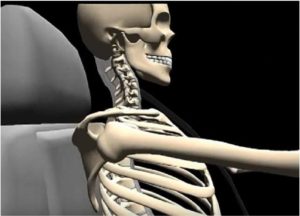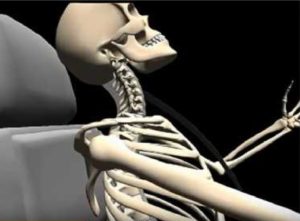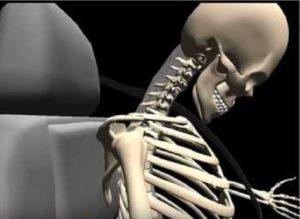How Whiplash Occurs in a Rear-End Car Accident
What is Whiplash aka a Cervical Strain?
The attorneys at Scottsdale Injury Lawyers have handled hundreds of car accident cases. Many of those involve rear-end accidents. In almost every serious rear-end car accident, our clients experience concussions and cervical strains.
Cervical strains are more commonly known as whiplash. According to the Mayo Clinic, a muscle strain is the pulling and tearing of muscle fibers or the attaching tendons. The cervical region of your spine includes the vertebrae in your neck. In other words, whiplash or a cervical strain is an injury to the muscles and tendons in your neck.
Strains can occur in any muscle. They are usually caused by the overstretching of a muscle. Strains, including whiplash, can result in the following symptoms: swelling, bruising, pain, weakness, stiffness, spasms, tightness and inability to use the muscles.
According to Harvard Medical School, strains have varying degrees of severity. In a mild strain, the muscles may feel a little stiff. In a severe strain, the muscles may not be usable due to the intense pain that results. Most strains resolve in 8-12 weeks with proper medical treatment. For mild strains, they may be treated with ice, heat, rest and anti-inflammatory drugs. For severe strains, physical therapy may be required.
Physical therapy is used to restore flexibility and strength to the damaged muscle following a strain injury. Physical therapy treatments may involve electric stimulation, soft tissue massage and therapeutic exercises. People generally recover fully from a strain injury. However, there are some cases where the damaged muscle fibers result in scarring that is permanent. This can cause the permanent loss of flexibility and limited range of motion.
Why Car Accidents Cause Whiplash?
Whiplash frequently occurs in a rear-end accident due to the acceleration forces placed on the neck muscles. When someone is rear-ended, they rapidly move from a position of rest to a high rate of speed. This creates forces on the neck causing the head to move back quickly and then forward. Based upon the speed of the at-fault vehicle and the resulting force of the impact, the forces on the neck can be severe. The g-forces placed on the neck can be several times that of normal living and cause the abrupt overstretching of the neck muscles and tendons. This causes damage and resulting injury.
The attorneys at Scottsdale Injury Lawyers regularly encounter whiplash injuries in car accident cases. Interestingly, our clients usually describe being thrust forward immediately after a rear-end impact. However, these clients are mistaken as to the dynamics of how their bodies travel after a rear end collision. This is because they are unable to process what happens to their body and head in the milliseconds after a substantial rear-end accident.
The Mechanics of a Rear-End Accident
When a client is rear-ended, his or her head initially moves backward and then snaps forward when the vehicle comes to rest. Indeed, this is why head rests are installed in vehicles. These safety devices are designed to prevent this rapid backward head movement and reduce injuries that may result from a rear-end accident.
Many people find it hard to believe that their heads move backward abruptly in a rear end collision. These people assume that they are propelled forward along with the car. This would be true if people were affixed to the vehicle, but this is not the case. People that are normally positioned in an automobile do not have their upper backs, neck and head pressed against the seat. When they are hit from behind, the vehicle moves forward and their upper bodies and heads move backward.
To illustrate this point, you can perform a simple experiment. First, take an object such as an eraser, block or deck of cards and place a coin on top of it. Second, strike it from “behind” and see where the coin goes. The object on the bottom will be pushed forward, the coin on top will move backward in the direction of the impact.
What occurs in a rear-end car accident follows the same mechanics. Initially, the head and neck is abruptly snapped back and then when the vehicle comes to rest snapped forward. Usually, the backward snap is limited by the head rest. However, the forward movement is not and can result in the chin touching the chest or the neck muscles being stretched even further. Although whiplash can occur from both the backward and forward movements, it is likely the forward movement that causes the majority of whiplash injuries.
Pictured above: The neck at rest, the neck thrust back at impact and the neck thrust forward.
For the same reasons describe above, lumbar strains are less likely than whiplash injuries in a rear end accident. The lumbar spine involves the vertebrae in the lower back. When people are seated in vehicles, their lower backs are usually in contact with the seats. As such, when hit from behind, the lower back does not travel back very far and is not subject to the same forces as the neck muscles. This is not to say that lower back strains do not occur in a rear-end car accident. They certainly do. They are just far less likely.
If you or a loved one were involved in a car accident in Scottsdale or the greater Phoenix area, call a skilled personal injury attorney from Scottsdale Injury Lawyers today. One of our Scottsdale attorneys is available to discuss your case and provide a free consultation.
About the author: The content on this page was authored and prepared by attorney Charles Tony Piccuta. He graduated with honors from Indiana University-Maurer School of Law in Bloomington in 2006 (Ranked Top 35 US News & World Report 2018). Piccuta took and passed the State bars of Arizona, California, Illinois and Nevada (all on the first try). He is a trial attorney that regularly handles serious personal injury cases and civil rights lawsuits. He has obtained six and seven verdicts in both state and federal court.
Disclaimer: The information on this web site is for informational purposes only and does not create an attorney-client relationship. If you are seeking legal advice, you should contact one of our attorneys and discuss your specific case and issues
Sources:
[1] https://www.mayoclinic.org/diseases-conditions/sprains-and-strains/symptoms-causes/syc-20377938
[2] https://www.health.harvard.edu/a_to_z/muscle-strain-a-to-z




